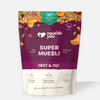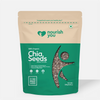
A Brief History Of Plant-Based Mylk, Starting From 1226 CE
Where does plant-based mylk come from, and why is suddenly everyone talking about it?
We don't know why it has taken this long to become so popular because in reality, plant-based mylk can be traced back in history from many different cultures.
This blog post will cover key moments in the history of plant-based mylk.

1226
Although plant-based mylks have been in use across the world for millennia, the first historical record of a mylk is an eleventh century Iraqi recipe book [referred to as A Baghdad Cookery Book]. It was written by Muhammad al-Baghdadi and contains numerous mentions of the use of almond mylk for different recipes.
In these recipes, the nuts are made into milk by being ground and mixed with water. Similar applications of almond mylk can be seen throughout the Middle-East. Further north, in England, a recipe book written in Old English records the use of almond mylk in a curry.
1390
The first English mention of almond milk comes from The Forme of Cury. It became widely used throughout Europe during lent and can be considered the first mainstream non-dairy milk alternative in the West.
1600s
Historical records suggest that soy mylk was consumed in several districts in China in the Qing Dynasty as a beverage. It was described as very watery so it probably wasn’t the same thick soy mylk that is known (and loved) today!
1800s
Although several mylks were made and used across the globe, soy mylk gained prominence with increased globalisation. In 1866, a French traveller in China described soy mylk as a drink in itself being consumed by his Chinese guides. Soy mylk was championed by people as varied as Henry Ford (who claimed the cow was the most inefficient means possible to get milk) and a Christian sect called the Seventh Day Adventists.

1910
In 1910, the first soy mylk dairy was set up near Paris. The owner applied for the first patent for soy mylk under the title ‘Vegetable milk and its derivatives’. However, at this time period soy mylk is still largely unpopular. In the US, soy mylk became an ersatz product—a product whose demand grew during wartime as a replacement for a more popular unavailable product—this will lead to it being less popular in the decades after the war as it came to be seen by some generations as an inferior substitute.
1920
Variations of what a plant-based mylk could be began to emerge. In 1921, a company called Vita Rice Products produced and sold the first rice mylk in San Francisco.
1930–1950
In Hong Kong, an entrepreneur named Kwee Seong Lo heard about soy mylk at a US Embassy in the 1930s. He went on to create a company that focused on producing soy mylk called Vitasoy. Vitasoy was one of the first companies to produce soy mylk as a distinct beverage, marketing it in unique curvy bottles much like the aerated drinks that dominated the market at the time.
This was to meet the need for a dairy-alternative by a largely lactose intolerant Chinese population. The company also added flavours to the mylk which made it extremely popular.
1977
A small startup is established in Boulder, USA that manufactured soy mylk. Silk will go on to become one of the largest selling plant-based mylk producers in the US.
1990
Rickard Öste, a food scientist studying lactose intolerance and sustainable food systems in Sweden, crafts the first batch of oat mylk that will go on to be the basis for Oatly. Oatly will go on to become the world’s largest selling oat mylk producer.
2000s
A variety of alternative mylks emerge to grab a share of the dairy market; coconut mylk, hemp mylk, pea mylk, and peanut mylk all begin to flood stores in the US and Europe. Soy mylk sales in the US peaked at $1.2 billion in 2008, the highest a plant-based mylk has reached until that point.
2017
A small company in India called One Good (formerly Goodmylk) set out to create the greatest plant-based dairy in the world by matching the taste, mouthfeel, and overall experience of cow’s milk. Without the cow of course!
If you’re curious to learn more about plant-based mylk, check out our latest blog posts on this topic:










Leave a comment